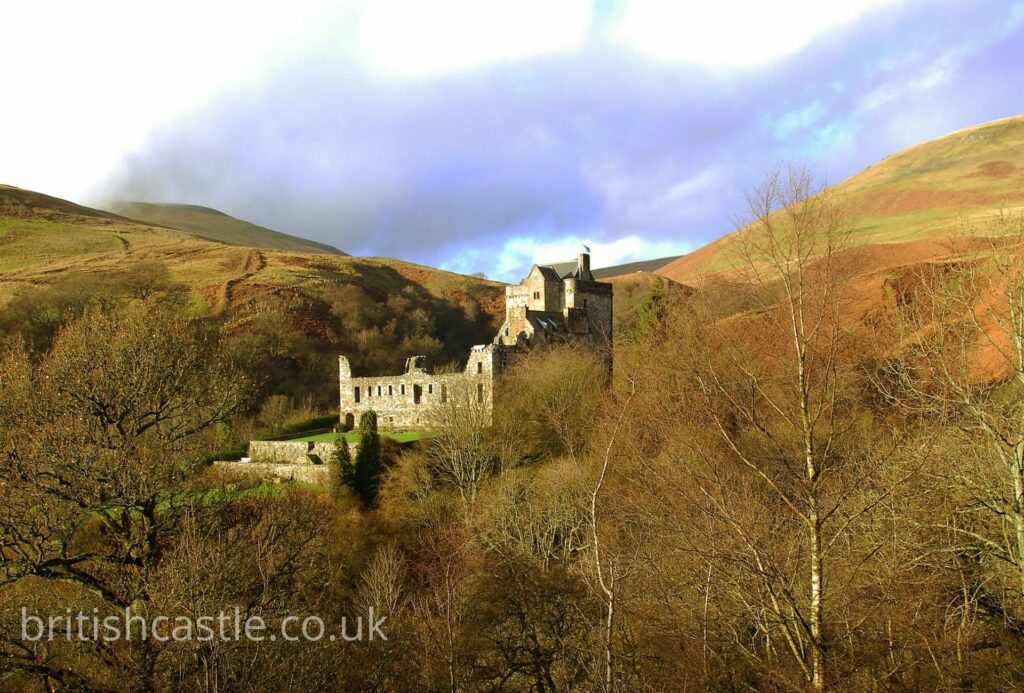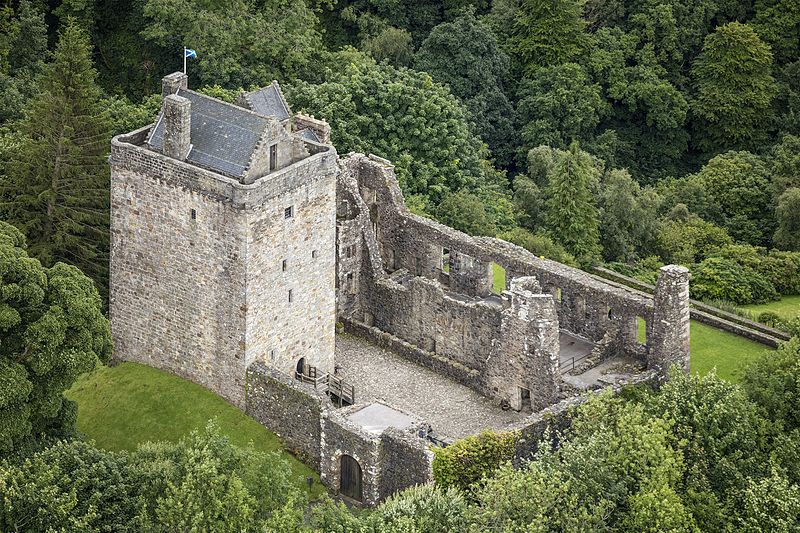Castle Campbell sits high and alone in the Ochil Hills, the hillsides plunging down at either side into the Burn of Sorrow and the Burn of Care in Dollar Glen.
The climb to the castle is difficult and would have been more so in its earlier history, given that the pathway and access would have been far more precipitous than it is now. The castle would have been a strong and virtually impregnable site in its early days. Originally known as Castle Gloom, its name and significance were transformed when it became the lowland seat of the earls and dukes of Argyll, marking a prestigious change approved by the parliament.

The castle overlooks the town of Dollar, about ten miles from Stirling, and the lands of -Dolar and Glume’ are mentioned in historical records of the twelfth century as belonging to the Bishop of Dunkeld.
It’s thought that a building of some kind would have existed at the time and it may have been a simple chapel or the remains of a Pictish fortification, but records do not give any details.
By the fourteenth century the lands were owned by the Stewarts, possibly through royal gift for loyal services to the crown. In 1466 the Vatican were preparing to take action against Walter Stewart of Lorne for his alleged destruction of a tower or keep in Glume, presumably because the land would have been consecrated ground under the ownership of the Bishop of Dunkeld.
Whether this building was on the site of where Castle Campbell now stands is not clear.

The lands came into the ownership of the Campbells in about 1489 by marriage and inheritance through the Stewart family. Colin Campbell, through his marriage to Isabel Stewart, Lord Lorne’s daughter, acquired the castle, solidifying the Campbell family’s power in central Scotland. The castle functioned as the Campbell seat of power in the lowlands, being closer to Stirling and Edinburgh where they maintained a high profile and given that their main residence was in Inverary, too far to travel on a regular basis.
The Campbells were Earls of Argyllshire, a powerful and politically prominent family with influence and position in the King’s household at Edinburgh, and upon application to King James IV in the year of the castle’s acquisition the name of the castle was changed from Castle Gloume, or Glume, to Castle Campbell.
The site was developed throughout the fifteenth century and included the construction of the main tower which dominates the view of the castle that one sees today. This medieval castle situated prominently in the landscape, with its significant tower house, became a symbol of the Campbell family’s architectural and historical legacy.
Further building work took place during the sixteenth century to extend the castle and to accommodate a growing household, and herbs and vegetables would have been grown in the grounds so as to make the household as self sufficient as possible given the castle’s remote position.
A long-standing feud between the Campbells and the MacLeans eventually led to the town of Dollar being attacked in 1645, and although the castle escaped damage on this occasion it proved vulnerable to the heavy artillery used in 1654 during the battles between Royalists and Covenanters. Argyll opposed Charles’ invasion, leading to the castle being burned by Royalist rebels, a pivotal event in the castle’s history.
The Scots had been defeated four years before by Oliver Cromwell and his Roundheads at the Battle of Dunbar, and revenge for the part the Campbells had played in the English victory and Cromwell’s gaining the title of Lord Protector of Scotland was bitter. The castle was attacked and burned by the Royalist MacLeans and evidence of the battle can still be seen in some of the fabric of the castle.
A garrison of English soldiers took possession for a short while after the attack and after their departure the castle was left to fall into decay and ruin. It remained empty for over 150 years and was finally sold by the 6th Duke of Argyll in 1807 to Crawfurd Tait of Harviestoun.
It was taken over by the National Trust for Scotland in 1948 who still own it, although Historic Scotland now manage the administration. The area has been designated as an Special Site of Scientific Interest (SSSI) because of its wide range of valuable flora and fauna.
Castle Campbell has seen some distinguished visitors throughout its history. John Knox preached from that part of the castle now known as the pulpit, Mary Queen of Scots spent some time here, and the castle’s romantic associations attracted and inspired artists as well as writers such as Robert Burns and Sir Walter Scott.
For visitor information including ticket prices and opening times please visit Historic Scotland’s Castle Campbell pages.
Find out about other Scottish Castles.